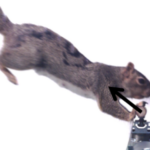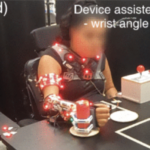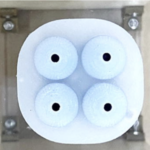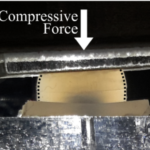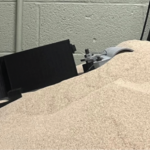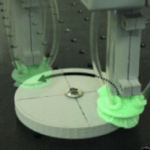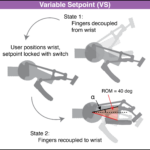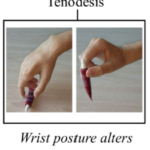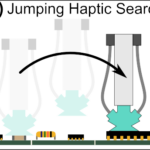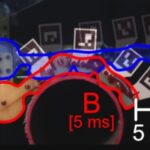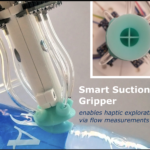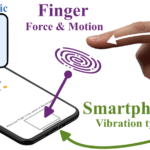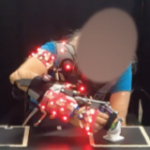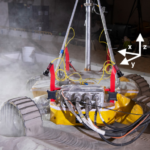Journal of Experimental Biology, April 2025
Lee, S, Wang, S, Kuang, D, Wang, E, Yim, J, Hunt, N, Fearing, RS, Stuart, HS, Full, RJ
Publications
This page provides information on full-length articles.
Research videos can be found at our YouTube channel.
Open access versions of publications can be found at eScholarship.
Short-form conference and workshop abstracts.
Open source files are at our Github page.
Last updated: May 2025
Expanding functional workspace for people with c5-c7 spinal cord injury with supernumerary dorsal grasping
IEEE Transactions on Neural Systems and Rehabilitation Engineering, December 2024
Lee, J, McPherson, AI, Huang, H, Yu, L, Gloumakov, Y, Stuart, HS
AcousTac: Tactile sensing with pneumatic-driven acoustic resonance for electronics-free soft skin
Soft Robotics, February 2025
Li, M, Stuart, HS
Smartphone haptics for tactile temporal discrimination: Preliminary insights into measurement of function
International Conference of the IEEE Engineering in Medicine & Biology Society (EMBC), May 2025
Torres, W, Abbott, M, Stuart, HS
Synchronicity: A measure of multi-joint movement coordination in device assessment
International Conference on Rehabilitation Robotics (ICORR), May 2025
Gloumakov, Y, Stuart, HS
Milli-scale AcousTac sensing using soft Helmholtz resonators
PREPRINT: International Conference on Robotics and Automation (ICRA), May 2025
Aderibigbe, J, Li, M, Stuart, H.S.
A tugging controller that maximizes lateral resistive force by mounding sandy terrain
PREPRINT: International Conference on Robotics and Automation (ICRA), May 2025
Moon, D, Huang, C, Page, J, Stuart, H.S.
Haptic contour following with the smart suction cup
International Conference on Intelligent Robots and Systems (IROS), July 2024
Sebastian Lee, Jungpyo Lee, Hannah Stuart
Fast in-hand slip control on unfeatured objects with programmable tactile sensing
IEEE Robotics and Automation Letters, May 2024
Yuri Gloumakov; Tae Myung Huh; Hannah S. Stuart
Robotically adjustable kinematics in a wrist-driven orthosis eases grasping across tasks
Annual International Conference of the IEEE Engineering in Medicine & Biology Society (EMBC) -- ArXiV preprint, July 2024
Chang, E. Y., McPherson, A. I., & Stuart, H. S.
A Grasp Taxonomy for People with C5-7 Spinal Cord Injury
Annual International Conference of the IEEE Engineering in Medicine & Biology Society (EMBC) PREPRINT, July 2024
McPherson, A. I. [Andrew I.W.], Adachi, K., Gloumakov, Y., & Stuart, H. S.
Nonlinear modeling for soft pneumatic actuators via data-driven parameter estimation
International Conference on Advanced Intelligent Mechatronics (AIM) -- ArXiV preprint, July 2024
Yang, W.-T., Stuart, H. S., Kurkcu, B., & Tomizuka, M.
A case study of student-community interaction through an education-first assistive device design class
ASEE Annual Conference, July 2024
Stuart, H. S., Torres, W. O., & McPherson, A. I.
Regrasping on printed circuit boards with the smart suction cup
International Conference on Robotics and Automation (ICRA), May 2024
Lee, J., Sun, Z., Dong, Z., Chen, F., & Stuart, H. S.
Squirrel-inspired tendon-driven passive gripper for agile landing
International Conference on Robotics and Automation (ICRA), May 2024
Wang, S. J., Kuang, D., Lee, S. D., Full, R. J., & Stuart, H. S.
Haptic search with the smart suction cup on adversarial object
IEEE Transactions on Robotics (T-RO), Nov 2023
Jungpyo Lee, Sebastian D. Lee, Tae Myung Huh, Hannah S. Stuart
Skin Sensitivity Assessment Using Smartphone Haptic Feedback
IEEE Open Journal of Engineering in Medicine and Biology, Oct 2023
Torres, W. O. [Wilson O], Abbott, M. E., Wang, Y., & Stuart, H. S.
Modulating Wrist-Hand Kinematics in Motorized Assisted Grasping With C5-6 Spinal Cord Injury
IEEE Transactions on Medical Robotics & Bionics (T-MRB), Oct 2023
Chang, E., McPherson, A. I., Adolf, R., Gloumakov, Y., & Stuart, H. S.
Self-care selfies: Patient-uploaded videos capture meaningful changes in dexterity over 6 months
Annals of Clinical and Translational Neurology, Oct 2023
Gopal, A., Torres, W. O. [Wilson O.], Winawer, I., Poole, S., Balan, A., Stuart, H. S., Fritz, N. E., Gelfand, J. M., Allen, D. D., & Bove, R.
Push-pull locomotion: Increasing travel velocity in loose regolith via induced wheel slip
Journal of Terramechanics, August 2023
Cyndia Cao, Deaho Moon, Colin Creager, Dennis K. Lieu, Hannah S. Stuart

